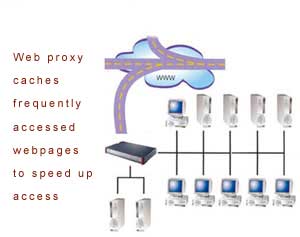Web proxy
 The bottlenecks
slowing web access nowadays are network congestion and server overload.
Web caching has been recognized as one of the most effective solutions
to alleviate these bottlenecks by keeping frequently accessed webpages
and images (Web objects).
The bottlenecks
slowing web access nowadays are network congestion and server overload.
Web caching has been recognized as one of the most effective solutions
to alleviate these bottlenecks by keeping frequently accessed webpages
and images (Web objects).
Speed up Web browsing
Web caching is done by running a service called a Web Proxy that processes web requests from within the network. The Web Proxy queries the remote Web servers and sends back the reply to the Web browser.
The next time the Web proxy gets a request for the same information,
it verify whether there is a newer object than the one stored in its
cache. If the Web object has not been modified, the Web proxy will
send the Web object which is stored in its cache to the Web browser
instead of retrieving the object from the remote Web server. This reduces
the amount of traffic going over the Internet link and speeds up Web
browsing.

Easy to set up
The Eland Appliance Web proxy service can be configured to intercept HTTP (Web protocol) traffic transparently and send back the requested information to the Web browser. This means that you do not need to reconfigure your Web browsers to experience the benefits of Web caching.
Secure Web browsing
A Web server can tell the Web proxy whether a Web objects should be cached or not and how long the object may be cached. This ensures that the Web browser is always served "fresh" information. The Web proxy does not cache secure Web objects (HTTPS requests) for security reasons; nor does it cache the results of scripts.
Restrict Web access
The Web proxy also allows you to restrict Web access to authorized users only. You can also restrict access to specific Web sites through Content Filtering.